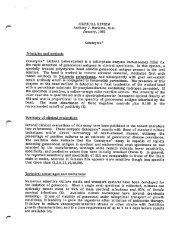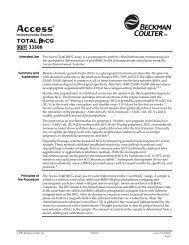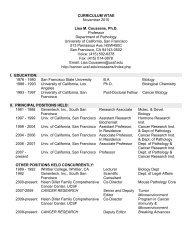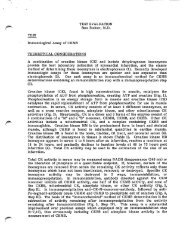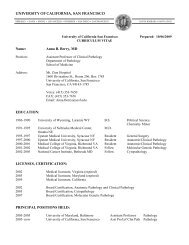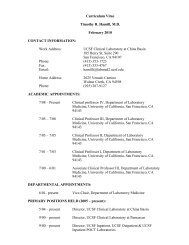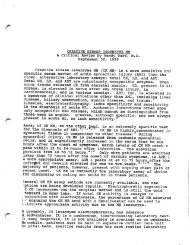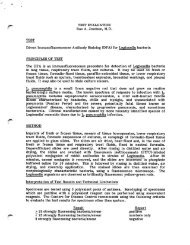Myelodysplastic Syndromes
Myelodysplastic Syndromes
Myelodysplastic Syndromes
Create successful ePaper yourself
Turn your PDF publications into a flip-book with our unique Google optimized e-Paper software.
MDS<br />
cytogenetics<br />
Presumptive diagnosis in<br />
patients with persistent<br />
cytopenias of undetermined<br />
origin but lacking diagnostic<br />
morphologic dysplasia<br />
(should be followed for definitive<br />
dysplasia before unequivocal dx)<br />
*Alone NOT considered<br />
definitive evidence for MDS<br />
(in absence of dysplasia):<br />
+8<br />
del(20q)<br />
Abnormality Frequency (diagnosis)<br />
Unbalanced<br />
-7 or del(7q) 10% (50% t-MDS)<br />
-5 or del(5q) 10% (40% t-MDS)<br />
+8* 10%<br />
del(20q)* 5-8%<br />
-Y* 5%<br />
i(17q) or t(17p) 3-5%<br />
del(11q) 3%<br />
del(12p) or t(12p) 3%<br />
-13 or del(13q) 3%<br />
del(9q) 1-2%<br />
idic(X)(q13) 1-2%<br />
Balanced<br />
t(11;16)(q23;p13.3) (3% t-MDS)<br />
t(3;21)(q26.2;q22.1) (2% t-MDS)<br />
t(1;3)(p36.3;q21.2) 1%<br />
t(2;11)(p21;q23) 1%<br />
inv(3)(q21;q26.2) 1%<br />
t(6;9)(p23;q34) 1%<br />
-Y WHO Classification of Tumours of Haematopoietic and Lymphoid<br />
Tissues, 2008.<br />
Flow Cytometry in MDS<br />
• Presently not routinely used for diagnosis or<br />
classification<br />
• Evaluation of previously diagnosed MDS by highly<br />
experienced flow labs with numerous myeloid<br />
markers and objective criteria for “abnormal” show:<br />
• Sensitivity: ~70-90%<br />
• Specificity: ~90%<br />
• ~10% flow abnormal with non-diagnostic<br />
morphology and cytogenetics<br />
– Insufficient data to determine whether these<br />
biologically behave like MDS (true or false pos?)<br />
FISH Analysis<br />
• Panels often include -5/del(5q), -7/del(7q), +8,<br />
and del(20q)<br />
• FISH correlates with karyotypic findings<br />
• FISH detects few (0-6%) additional abnormalities<br />
if karyotype is adequate and generally not needed<br />
in this setting<br />
• FISH useful if:<br />
– suboptimal metaphase analysis; detects up to 15%<br />
more abnormalities<br />
– morphology suggests a specific abnormality that was<br />
not detected by cytogenetics<br />
• Sensitivity for residual disease following treatment<br />
is not much better than routine karyotype<br />
Flow Cytometry in MDS<br />
Cautions<br />
• Reactive conditions (marrow recovery, G-CSF<br />
therapy, infection) can cause mild phenotypic<br />
alterations.<br />
• Insufficient literature to fully understand myeloid<br />
phenotypic change in reactive conditions that may<br />
mimic MDS<br />
• Blast assessment can be useful, but...morphologic<br />
blast count required for diagnosis and<br />
classification because:<br />
– Some blasts do not express stem cell antigens (CD34, CD117)<br />
– Processing for flow lyses erythroid precursors<br />
– Blasts can be fragile with a subset lost during processing<br />
7





